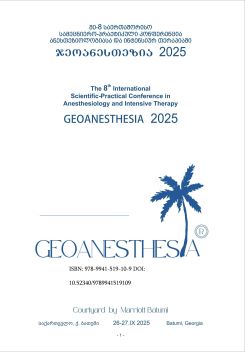Correlation of the number of COVID-19 infected people with ground-level ozone levels in Tbilisi in 2020-2022
DOI:
https://doi.org/10.52340/9789941519109.03Abstract
The aim of our study was to analyze the correlation between ground-level ozone levels and the number of COVID-infected people, as well as the number of hospitalizations due to complications caused by COVID-19.
March and April 2020 - these are the first days of the COVID-19 pandemic in Georgia. Thus, it is still too early to talk about the connection between ozone levels and hospitalization cases. This is also shown by the results of the correlation analysis between these two parameters - r = 0.3241, p = 0.092 (NS) and in April - r = 0.0994, p = 0.601 (NS). In the following months of 2020, the decrease in ground-level ozone levels mostly coincided with the increase in the number of COVID-19 cases. In the last month of the summer of the same year, when vacationers were actively moving to the resort area, a gradual increase in the number of COVID-19 cases began, while the ozone level indicator fluctuated without sharp changes.
There is a direct proportional relationship between the sharp drop in ozone levels and new cases of infection. In December 2020, the inverse relationship between COVID-19 infection rates and ozone levels across Tbilisi was already noticeable, with several thousand new infections occurring daily.
As for the study of the correlation between ozone levels and hospitalizations, only in February 2021 (r = -0.61, p < 0.001) and April (r = -0.38, p = 0.038) was a reliable inverse correlation between these parameters established.
During these two years, we averaged the results obtained due to daily fluctuations in hospitalizations and ground-level ozone levels by decades, and correlation analyses were conducted based on these decadal indicators. The correlation between hospitalizations and ground-level ozone levels was also analyzed by season and strain distribution period.
As a conclusion, we can suggest that there is a directly proportional relationship between a sharp drop in ozone levels and new cases of Covid-19 infection. Also, against the background of a decrease in ozone levels, the number of hospitalizations of COVID-infected patients significantly increased (- r = -0.6050, p < 0.001). Also significant is the fact that the Pearson correlation coefficient between the average ozone level and the number of hospitalizations of COVID-infected patients was - r = - 0.7860, p < 0.001. i.e. the relationship is significantly inversely correlated.
References
კორონავირუსის საქართველოში გავრცელების პრევენცია. www.stopcov.ge.
Abdolshahi A, Emadi A, Eslami M. Potential therapeutic effect of oxygen-ozone in controlling of COVID-19 disease. Med Gas Res. 2022;12(2):33-40.
Adam MG, Tran PTM, Balasubramanian R. Air quality changes in cities during the COVID-19 lockdown: A critical review. Atmos Res. 2021;264:105823.





